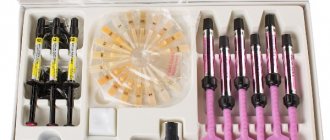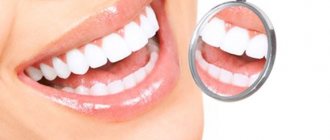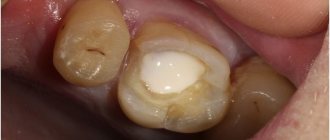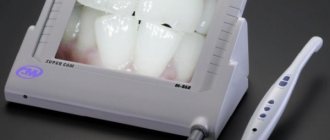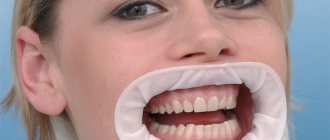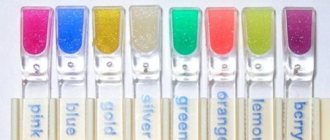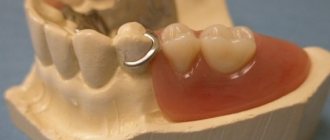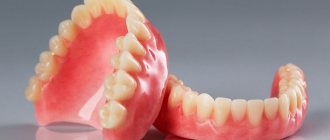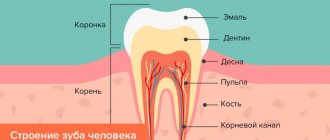8363
Those years when a visit to the dentist and the procedure for filling an affected tooth were the subject of physical and moral torment are far in the past.
Now, thanks to innovative scientific developments, high-quality and safe materials and modern equipment, monitoring the health of the oral cavity and promptly eliminating problems that arise has become comfortable and harmless.
This article will discuss the currently best filling material Estelite.
General overview
Estelite Sigma Quick is a modern composite mass, specially developed by Japanese specialists in the field of dental practice for filling teeth.
The drug is a universal set of elements characterized by radiopaque characteristics and excellent light-curing properties.
Combined with a high aesthetic factor and fast polymerization processes, the material has proven itself in clinics around the world, being one of the best products among its product range.
Installation of Estelite filling at the Elident clinic
Elident is a dental clinic that uses filling materials from well-known and high-quality manufacturers. Installing such a filling will allow you to restore your teeth’s aesthetics, anatomy and chewing functionality, which is a guarantee of durability.
The clinic is equipped with modern, imported equipment and good anesthetics will allow all procedures to be carried out painlessly. Our highly qualified specialists will provide treatment at the highest level and make your discomfort minimal.
Composition and properties
A high-quality result and a high strength index are ensured due to excellent mechanical and physical characteristics due to the presence of all the constituent elements of the composite.
More than 80% of it consists of silicon-zirconium mass, which ensures minimal shrinkage of the material subsequently .
Choosing the right shade is quite easy - the product line includes about two dozen color options. The composition is perfectly polished, and the high-quality result lasts for a long period of time.
The mass is resistant to abrasion and has the highest wear resistance class.
In what clinical cases is the method of retrograde root canal filling justified?
Come here to get to know Filtek filling material better.
At this address https://www.vash-dentist.ru/lechenie/zubyi/plombyi/stekloionomernogo-tsementa.html we will discuss the pros and cons of glass ionomer cement for filling teeth.
Advantages of Estelite
- Precise contact does not allow caries to stand out.
- All-ceramic crowns are stronger than metal-ceramic crowns and will serve you reliably and for a long time.
- Biocompatibility of matter with gum tissue.
- Good light transmission and a wide range of colors in the palette.
- Due to the natural transition of color from the pointed edge to the dentin, crowns are difficult to distinguish externally from natural teeth. A combination of color and shape from a healthy tooth.
- To avoid injury to healthy teeth with a prosthetic crown, its abrasion is exactly close to the abrasion of natural teeth.
- Lasting protection from negative influences from outside substances and microorganisms.
And now, of course, a little about the installations in our clinics, read on.
Principle of operation
During the use of the material, dentin fragments are filled with the drug simultaneously, which allows achieving the same depth of internal penetration of adhesives and demineralization of the composition. The monomer forms a single structure through its 100% filling .
Regardless of the quality of the working area - dry, wet, or having undergone a preliminary preparation procedure, the adhesion force will be equally reliable.
The doctor is obliged to calculate the filling boundary as accurately as possible - a colored pigment will help him with this, which will subsequently disappear from the surface of the tooth on its own.
An important characteristic of the drug , which distinguishes it from analogue options, is a decrease in enamel sensitivity and a decrease in permeability.
Main advantages of Estelite:
- versatility of use;
- simplicity and ease of use.
Advantages
The main advantages of using the Japanese Estelite material are its versatility and aesthetics. The brand’s nanocomposite called “Sigma Quick” is suitable for the restoration and restoration of both chewing teeth and the anterior row.
The filling material “Estelight Sigma Quick” has many advantages:
- used both to restore color and to give the correct shape to the front or lateral dentition;
- high wear resistance (tooth enamel does not wear off or deform during prolonged use);
- a large number of shades, which makes it possible to choose the most suitable one for the dentition;
- has a “chameleon effect” (the filling acquires the shade of the tooth over time, this in turn minimizes the incorrectly selected material);
- simplicity and speed of application;
- the surface of the tooth is shiny and smooth.
But the Russian market also offers Italian-made material “Estelight Asteria”, which has similar qualities and advantages to the Japanese product. The only difference between these two filling materials is that “Asteria” has a somewhat limited range of colors, and is also applied to the tooth in two layers. The remaining characteristics, high quality, and also the price are almost the same.
Indications and contraindications
Due to the almost complete versatility of the product, the range of indications for its use is quite wide.
The drug can be used in most clinical situations, in particular:
- for direct restoration of the frontal zone of the jaw row , for example, for small anterior cavities
- when eliminating minor surface defects caused by mechanical damage - cracks, chips;
- as a base layer when performing direct restoration;
- for the treatment of organs by indirect restoration;
- to eliminate external defects of other previously applied composite materials;
- restoration of artificial row fragments;
- elimination of gaps and diastemas of varying degrees of severity;
- in the process of forming composite veneers - when applying the thinnest multi-layer overlays;
- therapy of caries manifestations of all types.
Since the component contains methacrylic monomers, the main contraindication to the use of the mass is individual intolerance to this element, as well as a tendency to develop allergies to methacrylics and similar compounds.
Estelite Asteria – highly aesthetic restoration material
A new product in dentistry from the super brand Tokuyama (Japan), Estelite Asteria is designed to create highly aesthetic composite restorations using a simplified technique.
Asteria material is supplied in a standard 4 gram syringe. It has an excellent internal structure, which makes it possible to quickly and efficiently polish the restored surface. The material was developed on the basis of the composite material Estelite Sigma, which has been supplied to the Russian market for 14 years, and has proven itself only on the positive side with excellent long-term results.
Easy color selection, the ability to use dyes and bonding systems from Tokuyama Dental.
The line includes 12 shades in two degrees of opacity: Body and Enamel. Body shades - they perform the bulk of the restoration:
Estelite Asteria Syringe A1B, A2B, A3B, A3.5B, A4B, B3B, BL. Enamel shades - applied to the entire surface of the restoration.
Recommended thickness for anterior teeth is 0.2-0.5 mm, for chewing teeth 0.5-1.0 mm. NE-natural enamel, OcE-occlusal enamel, TE-transparent enamel, YE-yellow enamel, WE-white enamel. Body shades perfectly harmonize with tooth tissues with a minimum width of the enamel bevel and have sufficient opacity to mask discolorations. Excellent “chameleon” effect. Polishable in 60 seconds! The patented special composite matrix provides maximum elasticity and reduced polymerization stress. The innovative photopolymerization initiator guarantees absolute color stability of the restoration over time.
Estelite Asteria Syringe (individual syringes): A1B, A2B, A3B, A3.5, A4B, B3B, BL, NE, WE, YE, TE, OcE 4.0 g (2.1 ml).
Registration certificate for a medical device No. RZN 2014/1792 dated August 1, 2014.
Description for specialists:
ESTELITE ASTERIA Synthetic Filling Material Please read all information, precautions and notes before use.
DESCRIPTION OF THE DRUG AND GENERAL INFORMATION:
1) ESTELITE ASTERIA is a light-curing, radiopaque composite material intended for use in the restoration of anterior and posterior teeth.
Suitable for all classes of carious cavities, including restorations requiring minimal or no cavity preparation.
ESTELITEASTERIA contains 82% by weight (71% by volume) silicon-zirconium composite filler. The high degree of filling of the composite ensures low polymerization shrinkage. The inorganic filler contained in ESTELITE ASTERIA is a spherical filler (average particle size: 200 nm, particle size range: 100 to 300 nm) providing excellent gloss retention and abrasion resistance.
ESTELITE ASTERIA contains Bisphenol Adi-(2-hydroxypropoxy) dimethacrylate (Bis-GMA), Bisphenol A polyethoxy methacrylate (Bis-MPEPP), 1,6-bis-(methacryl-ethyloxycarbonylamino)-trimethylhexane (UDMA), triethylene glycol dimethacrylate ( TEGDMA), mequinol, dibutyl hydroxyl toluene, and UV absorber.
2) The ESTELITE ASTERIA material uses photopolymerization acceleration technology (Radical-Amplified Photopolymerization initiator technology – RAPtechnology). Photopolymerization acceleration technology reduces polymerization time and provides longer working time for the material (90 sec).
Pay attention to the table of the dependence of polymerization time on the permissible thickness of the material layer (INSTRUCTIONS FOR APPLICATION AND POLYMERIZATION).
3) ESTELITE ASTERIA is available in SYRINGES.
INDICATIONS:
- Direct restoration of anterior and posterior teeth, including the occlusal surface of the teeth
- Dental restoration with direct composite veneers
- Diastema closure
- Repair of ceramic/composite restorations
Basic guide to using Estelite Asteria (Russian voice acting)
In this video, Dr. Noboru Takahashi, founder of the Asteria project, talks about the characteristics and features of using the composite filling material Estilite Asteria. The video contains clear clinical examples.
Rules for tooth preparation
Preparing the organ for the upcoming manipulation is an important process of therapy in general. Like the main stages of restoration, it is carried out strictly in accordance with the protocol and includes the following sequential actions of the doctor:
- cleaning the enamel - the surface of the jaw row is carefully but thoroughly cleaned with a special rubber container with a mass that does not contain fluoride components. After treatment, the working area is washed with water;
- tone selection – carried out using a shade scale. For the most accurate result, the selection time is a few minutes, since wet teeth are darker, and dry teeth, on the contrary, are lighter.
The main principle of selection is color saturation; from the most suitable options, the specialist will choose the most intense.Important! Professional whitening cannot be performed before the procedure. In this case, there is a high risk of tone discrepancy, since some time after bleaching the organs will become darker and the discrepancy will be noticeable;
- insulation – the best option is rubber dam;
- preparation - manipulation is carried out according to the standard procedure, after which the surface is washed with water. When treating the frontal zone, bevels are made along the marginal part of the enamel, and in the lateral zone, the edges are somewhat smoothed. This will improve retention and aesthetic perception;
- pulp protection - if the working cavity and the pulp are located nearby, a gasket is applied, which serves as a barrier protecting the delicate pulp tissue.
It is made from glass ionomer or calcium hydroxide. The use of eugenol and its derivatives as protection is not recommended, since the material impairs the polymerization process of Estelite; - application of adhesive - single-component mixtures with this filling composition are shown. However, they should not be self-curing, since the material will not provide the necessary adhesion effect.
Indications and contraindications for unfilling tooth canals.
In this article we will talk about the composition and properties of the Spectrum filling.
Here https://www.vash-dentist.ru/lechenie/zubyi/plombyi/restavratsii-tsementnyih.html read about the service life of cement fillings.
Estelite Sigma Quick shades
A1, A2, A3, A3.5, A4, A5, B1, B2, B3, B4, C1, C2, C3, OA1, OA2, OA3, OPA2, BW (Bleach White), WE (White Enamel , white enamel) and CE (Clear Enamel/Incisal, transparent enamel/incisal shade).
Opalescent shades (OA1, OA2, OA3) have adequate degree of opacity necessary to block the darkness of the oral cavity (restoration of class III and IV cavities)
Opalescent shades can also be used as dentin shades for layer-by-layer multi-shade restorations. The shades OA1, OA2 and BW are well suited for the restoration of primary teeth. However, they are not intended for use as camouflage agents for metal teeth or highly discolored teeth such as tetracycline teeth.
OPA2 is intended for use as a camouflage agent for the treatment of minor stains, as well as for the restoration of opaque teeth (applied in a thin layer to the lingual wall of a Class III and IV cavity).
Stages of restoration
Unidoses should be used only within the instructions for use of the composition.
An ounce is measured in the dispenser, then the protective cap is removed. The paste is squeezed directly into the working cavity or preliminarily brought to the required consistency on a tablet.
If a syringe is used, the operating principle is as follows:
- remove the cap;
- turn the handle clockwise;
- squeeze the required amount of component onto the tablet;
- knead the paste.
After the material is ready for use, filling and restoration contouring begin . The paste is introduced into the hole in layers, not exceeding the maximum permissible depth in one application. The manufacturer offers a special table for this.
During the filling process, mixing Estelite with other pastes is unacceptable; this is fraught with the formation of voids and poor-quality polymerization.
Each layer must be polymerized separately - the time stated by the manufacturer. The device is located at a distance of about 2 mm from the working area.
The final stage is finishing. The restoration area is cleaned and polished using fine-grained diamond burs.
To make the boundaries between the filling and the tooth look as natural as possible, the doctor performs fractional grinding with a multifaceted carbide bur. No water is used, and the rotation speed of the bur is minimal.
The proximal parts are treated with special thin strips of vinyl or medical metal alloy.
The finished surface is polished with rubber nozzles or special devices designed for this.
The video provides a basic guide to using Estelite filling material.
Indications for use, preparation and application
The universal characteristics of high-quality fillings formed using Estelite provide a wide range of possibilities for use. Possible clinical indications include:
- restoration of the frontal jaw area;
- correction of surface defects on enamel;
- direct restoration of the base layer;
- restoration of installed prostheses;
- elimination of gap-like spaces and diastemas;
- therapeutic prevention of caries.
The presence of methacrylic-based monomers in the composition of the drug is a key factor limiting the possibility of use for people suffering from allergic reactions to compounds of this group. Intolerance to this element should be clarified before starting therapy.
When preparing the oral cavity for medical restoration, a number of procedures are performed in the required sequence:
- Cleaning the enamel layer using a special mass that does not contain fluoride;
- Selecting a color tone using a shade scale;
- Isolation of the dentition element using latex plates;
- Standard preparation followed by rinsing with water;
- Pulp protection with an artificial glass ionomer barrier;
- Application of the composition and formation of the restoration contour.
During the restoration process using Estelite, it is recommended to strictly follow the instructions for use. The composition is applied either directly into the working cavity of the tooth, or squeezed out of a syringe onto a separate tablet to give the desired consistency. The introduction into the hole is carried out layer by layer, without exceeding the depth, and each layer must undergo a polymerization procedure, the duration of which is determined by the manufacturer’s special table. It is important to note that mixing the composition with other restorative pastes leads to the formation of voids and defects in the final polymerization.
At the final stage, the finished filling is processed and polished using a fine-grained drill. To improve the aesthetic perception and appearance, fractional grinding technology is used at minimum speed, without the use of water. Proximal elements should be treated with vinyl or metal strips. The finished shape can be further polished using a special rubber nozzle or other device.
Precautionary measures
When working with the material, you must comply with the safety requirements stated by the manufacturer. In particular:
- do not use the component for other purposes;
- the product has a target orientation and is recommended for sale only to medical institutions and individuals who are practicing dentists;
- It is better to refuse to use the product if there is even the slightest doubt about its authenticity, for example, the seal of the packaging is broken, or there are no special seals;
- at the first signs of individual intolerance, work must be stopped immediately;
- methacrylic monomers are classified as allergens, so the composition should only be used with protective gloves. You should be aware that the material has the ability to penetrate latex; at the end of the procedure, your hands should be rinsed well with running water;
- do not allow direct contact of the drug with the skin, and if there is the slightest contact with the body or eyes, rinse the affected area and contact a specialized specialist;
- After the session, the patient is recommended to rinse the mouth generously;
- it is contraindicated to inhale Estelite vapors or swallow its contents - this can lead to irreversible health consequences;
- at the end of the manipulation, all instruments that had direct contact with the filling mass are treated with alcohol;
- During work, the specialist must wear safety glasses.
Artistic restoration of teeth
- Description
- Prices
- Doctors
- Equipment
Hurry up to take advantage of our dentistry's summer offer! Artistic restoration with premium materials at a 40% discount, 4500 rubles instead of 7700 rubles turnkey! And a 20% discount on composite veneers. For artistic dental restoration, we use only the best nanocomposite materials: Japanese material Estelite Asteria and Italian Enamel plus HRi. Artistic restoration of teeth Promotion! 4500 rub.
Americans say: “What does your smile say about you?” (What does your smile say about you?).
Prices for artistic dental restoration
| Artistic restoration with Enamel plus HRi* material on special offer | 4500 |
| Production of composite veneer from Estelite Asteria** material on special offer | 6400 |
| Production of composite veneer from Enamel plus HRi** material on special offer | 9200 |
Included in the price:
Artistic restoration (aesthetic filling)*
- Anesthesia and pain relief
- Preparation for filling (preparation, medicinal treatment, application of a gasket, etc.)
- Filling with nanocomposite material Enamel plus HRi
- Occlusion control, grinding, polishing, etc.
Direct method veneers (composite veneers)**
- Anesthesia
- Modeling teeth on wax
- Tooth treatment
- Taking impressions
- Individual selection of veneer shape and color
- Making a veneer
- Fixation of veneer
Aesthetic dental restoration
Modern aesthetic dentistry does everything so that your smile speaks of your success, your beauty and health. One of the methods for achieving a perfect smile is the method of artistic restoration.
Artistic restoration of teeth is a process of aesthetic imitation of dental tissue using artificial materials, thanks to which the natural structure of the tooth is restored.
It is worth noting that today this popular procedure has become completely painless.
This technique is used in cases:
1. If it is necessary to change or restore the shape of a tooth.
2. If the tooth is destroyed (including caries).
3. If a tooth is chipped.
4. If caries appears under the filling.
5. If correction of the contour of the teeth is necessary for the aesthetic beauty of the smile.
Briefly about methods of artistic restoration of teeth
The required restoration method is determined by the doctor, depending on the area of restoration (smile area or chewing area), the amount of destruction of a particular tooth and the amount of work in general (the number of teeth being restored).
If the installation of a filling is indicated for teeth, then as part of artistic restoration a filling made of nanocomposite materials is installed, which allows you to completely imitate the relief, transparency and color of the tooth being restored - the aesthetic norm.
After such a restoration, it is almost impossible to determine the location of the filling with the naked eye.
If the installation of veneers is indicated, then, depending on the number of teeth and other factors, we choose either a composite restoration of teeth (direct or, as they are also called, composite veneers), or an indirect restoration method (laboratory veneers).
Below we discuss in detail the methods of artistic restoration.
Very often, the patient is shown a combination of several methods of dental restoration. Sign up for a free consultation to get a detailed restoration plan for your smile.
Artistic restoration of anterior teeth
There are two methods of artistic restoration of anterior teeth:
1. Aesthetic restoration, restoring the natural shape and color of your tooth.
2. Total composite restoration, which allows, if necessary, to completely change the shape and color of the tooth.
Aesthetic restoration of anterior teeth
It is used to restore areas of the tooth partially destroyed by caries or as a result of mechanical trauma.
Various composite materials are used for this work. We use Estelite Asteria and Enamel plus HRi.
In essence, aesthetic restoration is the same as dental filling, only using premium composite materials and with absolute attention to the shape, transparency and color of the filling.
After a while, you yourself will forget which tooth you have a filling on. And the filling, thanks to higher quality materials, is much more durable and more resistant to chipping and darkening.
Total composite restoration of anterior teeth
Total restoration of teeth with composite material is carried out immediately in the patient’s oral cavity using the latest generation materials - these are composite veneers.
Composite restorations are installed using a more gentle preparation with minimal invasive intervention. One or more of these composite veneers can be placed on your teeth in just one visit.
And although composite veneers are inferior to ceramic veneers in terms of resistance to abrasion, smoking and food dyes, their comparative economic availability, immediate production and relative ease of adjustment (in the future) make this type of artistic dental restoration the most popular among patients.
But the main thing is that with the direct composite method of artistic restoration, teeth look very natural, thanks to the aesthetic properties of the Enamel plus HRi material. It is easy to understand what the naturalness of a tooth is if you compare a metal-ceramic crown and living teeth of the same whiteness.
The aesthetic qualities of direct (composite) veneers are higher because the teeth look more natural.
Indirect method of restoration of anterior teeth
The indirect method is the restoration of the smile area with laboratory veneers, that is, veneers are made in the laboratory from various ceramic materials.
This is a more expensive and complex procedure, which consists of several stages:
1. Preparing the tooth for restoration, taking impressions.
2. Production of ceramic (or zirconium, porcelain) veneers in a dental laboratory.
3. Installation of veneers on teeth. In total, with this method, it takes a dentist from several days to a month to place veneers.
Here is a video example of installing indirect veneers on teeth:
Artistic restoration of chewing teeth
The artistic restoration of chewing teeth is not much different from the aesthetic restoration of the front teeth.
This kind of work cannot be called simply installing a filling, because the chewing teeth require no less attention than the front teeth.
When filling chewing teeth, it is also important to restore their natural shape, reproduce the surface microrelief, as well as the shape of the cutting edge. This allows you to maintain 100% bite and chewing function of the tooth.
Of course, this matter cannot be done without modern nanocomposite materials.
The Estelite Asteria restoration composite is quite suitable for chewing teeth, since the area of chewing teeth is not subject to such stringent requirements for the aesthetics of restoration. At the same time, in terms of strength, fit and durability, this material is not inferior to the Enamel plus HRi composite.
Prices for artistic dental restoration
| Service | price, rub. |
| Artistic restoration using Enamel plus HRi* | 7700 |
| Making a composite veneer from Estelite Asteria** material | 8000 |
| Production of composite veneer from Enamel plus HRi** material | 11500 |
Included in the price:
Artistic restoration (aesthetic filling)*
- Anesthesia and pain relief
- Preparation for filling (preparation, medicinal treatment, application of a gasket, etc.)
- Filling with nanocomposite material Enamel plus HRi
- Occlusion control, grinding, polishing, etc.
Direct method veneers (composite veneers)**
- Anesthesia
- Modeling teeth on wax
- Tooth treatment
- Taking impressions
- Individual selection of veneer shape and color
- Making a veneer
- Fixation of veneer
The appointment is conducted by dentists
Levchuk Diana Arshakovna
Orthopedic dentist, specializes in aesthetic treatment and prosthetics. Has 15 years of experience in therapeutic and orthopedic dentistry. Performs complex endodontic operations using a microscope.
Chernykh Anastasia Leonidovna
Dentist-therapist, specializes in the treatment of caries, endodontic treatment and cosmetic dentistry. Extensive experience in pediatric dentistry.
Karaseva Daria Sergeevna
Dentist-orthodontist, correction of bite and teeth position. Has extensive experience in therapeutic and cosmetic dentistry.
Equipment
Gendex Expert DC 75/DC 65 is a high-frequency wall-mounted X-ray unit.
This device is part of the premium line of radiographic equipment from the largest German company in this field, Kavo.
High frequency X-ray technology with constant current generator provides consistent quality, short exposure times and low radiation dose to the patient.
Standard curing dental lamp.
The dentist uses such a lamp when filling a tooth with a light-curing material, including nanocomposite.
We use a lamp from Woodpecker - this is a serious manufacturer that offers high-quality polymerization lamps with powerful and stable light.
Release forms and price
The drug is produced in syringes. The cost of one serving varies from 1,500 to 2,200 rubles, depending on the type of component.
The set usually contains 6 (test) or 9 (standard set) syringes. Accordingly, you will have to pay from 12,000 to 19,000 rubles for the set.
Reviews
Estelite is a reliable, durable and convenient composition that greatly simplifies the dentist’s work. It has virtually no analogues.
If you are interested in the topic of this article, the main characteristics and principle of filling with this material, you can leave your feedback in the “comments” section.
If you find an error, please select a piece of text and press Ctrl+Enter.
Tags filling fillings
Did you like the article? stay tuned
Previous article
Nutrition for stomatitis
Next article
Twinky Star colored fillings are the best solution for filling baby teeth
